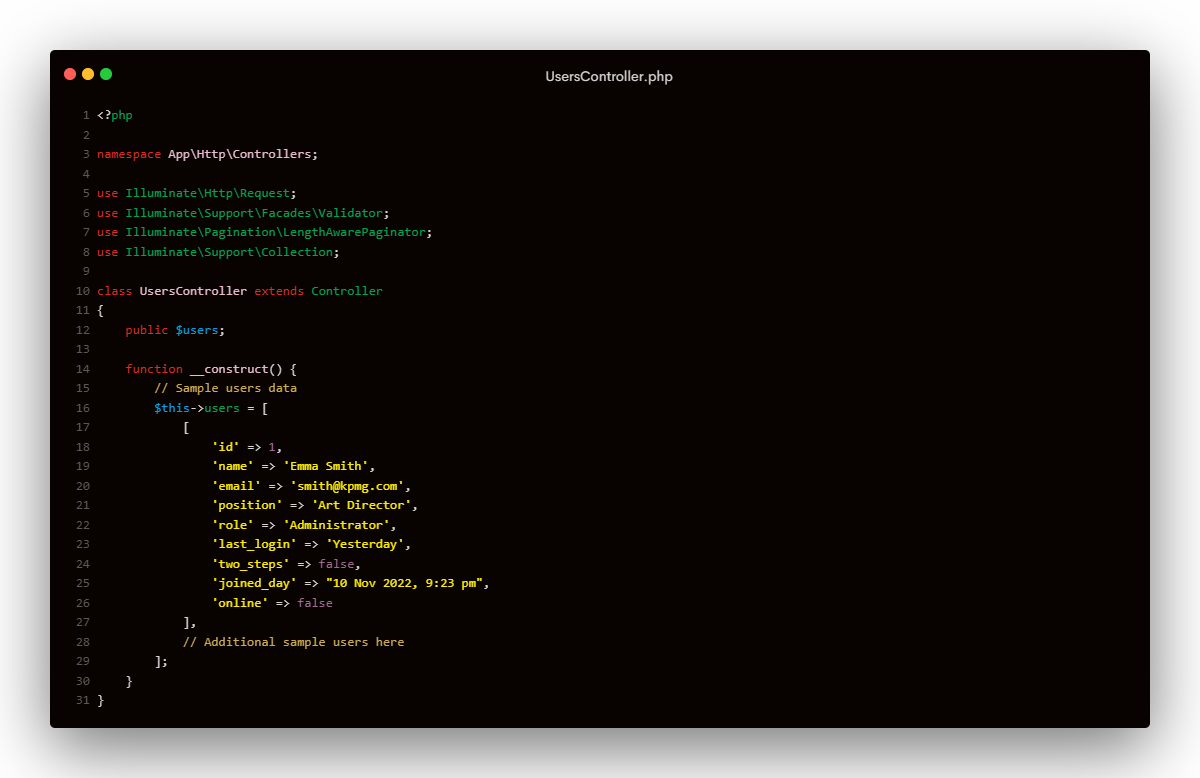Working on a Laravel project and need sample user data for testing purposes? Setting up a mock controller with some realistic user data can be a great approach, especially if you're prototyping or want to focus on front-end features without setting up a database. In this article, we’ll walk through creating a UsersController in Laravel that provides mock user data and implements CRUD operations for demonstration and testing.
1. Setting Up the Controller
To begin, create a new controller in Laravel named UsersController. This will serve as our mock API endpoint for managing user data. We’ll store our user data in an array, simulating a database table.
<?php namespace App\Http\Controllers; use Illuminate\Http\Request; use Illuminate\Support\Facades\Validator; use Illuminate\Pagination\LengthAwarePaginator; use Illuminate\Support\Collection; class UsersController extends Controller { public $users; function __construct() { // Sample users data $this->users = [ [ 'id' => 1, 'name' => 'Emma Smith', 'email' => 'smith@kpmg.com', 'position' => 'Art Director', 'role' => 'Administrator', 'last_login' => 'Yesterday', 'two_steps' => false, 'joined_day' => "10 Nov 2022, 9:23 pm", 'online' => false ], // Additional sample users here ]; } }
This constructor method initializes an array of user data. Each user has attributes like id, name, email, role, and last_login. You can customize these attributes to fit your needs.
2. Fetching Users List with Pagination and Filters
Our next step is to create a method to fetch all users, including pagination and filtering functionality. This helps us simulate a real database where we can retrieve, sort, and filter data.
public function getUsers(Request $request) { $usersCollection = collect($this->users); $page = $request->input('page', 1); $perPage = $request->input("items_per_page", 10); // Search and filter logic here // Paginate users $paginatedUsers = $this->paginate($usersCollection, $perPage, $page); return response(["data" => $paginatedUsers->toArray()], 200); }
This method retrieves users as a collection and paginates the results. We also implement a helper function paginate() to manually paginate the data.
3. Adding a User
Adding a new user in this mock setup requires validating the input and appending it to our users array. Here’s how:
public function addUser(Request $request) { $data = json_decode($request->getContent(), true); $validator = Validator::make($data, [ 'name' => 'required|string|max:255', 'email' => 'required|string|email|max:255', 'role' => 'required|string|max:255', ]); if ($validator->fails()) { return response(["errors" => $validator->errors()], 422); } $data["id"] = count($this->users) + 1; $this->users[] = $data; return response(["data" => $data], 201); }
This function adds a new user only if the data is valid, simulating the behavior of a real database-backed POST request.
4. Updating User Data
Updating a user’s information is similar to adding a new user, but here we first locate the user by ID, then update the existing array entry:
public function updateUser(Request $request, $id) { $data = json_decode($request->getContent(), true); $validator = Validator::make($data, [ 'name' => 'required|string|max:255', 'email' => 'required|string|email|max:255', 'role' => 'required|string|max:255', ]); if ($validator->fails()) { return response(["errors" => $validator->errors()], 422); } $user = collect($this->users)->firstWhere('id', $id); if (!$user) { return response(["message" => "User not found"], 404); } $user = array_merge($user, $data); return response(["data" => $user], 200); }
5. Deleting a User
Deleting a user is as straightforward as removing the user by ID from the array. Here’s a simple deleteUser function:
<?php public function deleteUser($id) { $key = array_search($id, array_column($this->users, 'id')); if ($key === false) { return response(["message" => "User not found"], 404); } unset($this->users[$key]); return response(null, 204); }
6. Creating the Paginate Function
Since we’re working with an array instead of a database, we need a custom paginator. Here’s a function to handle manual pagination:
<?php public function paginate($items, $perPage = 10, $page = null) { $page = $page ?: (Paginator::resolveCurrentPage() ?: 1); $items = $items instanceof Collection ? $items : Collection::make($items); return new LengthAwarePaginator($items->forPage($page, $perPage)->values(), $items->count(), $perPage, $page); }
The paginate function lets us handle pagination just like we would with Eloquent collections.
Wrapping Up
With this setup, you now have a fully functional mock user controller in Laravel! This mock controller can be extended with additional endpoints or adapted to handle more complex mock data requirements. Whether you’re building a front-end prototype or testing Laravel API responses, this approach can save you time and simplify your development process.
You can get the complete code here on Github
